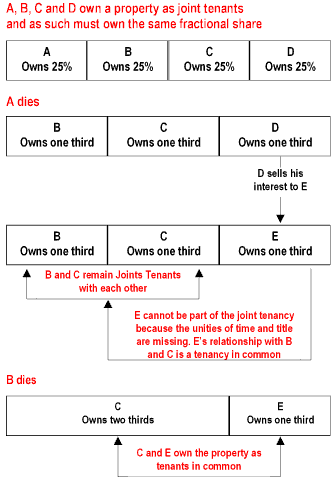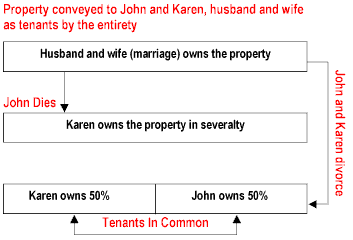The notes below are intended only to supplement a complete and diligent review of the related chapter in your course text. Studying these notes alone is not expected to be adequate test preparation.
TYPES OF OWNERSHIP
ęCopyright 1998 - 2008 Tim Wyman. All rights reserved. Reproduction in whole
or in part in any form or medium without express written permission of is prohibited. See Terms & Conditions to use this
material.
Real property can be owned by a
single individual or may be co-owned by two more persons at the
same time. When real estate is acquired, the form of ownership
chosen will impact on the rights of the parties involved. The type
of ownership can affect the transferability or inheritance of the
property as well as taxes and exposure of the property to
creditors. It is important to consider the impact of the
type of ownership on the property owner as well as those around
him or her who may be affected by the form of ownership chosen.
Practicing real estate agents should have a clear understanding
of the different ownership possibilities but should recommend that
experienced legal and/or tax advice be sought by the buyer in
every transaction.
Ownership in severalty or tenancy in severalty:
-
the word severalty comes from SEVER
which means to keep apart, divide, or separate
-
ownership is vested in one person only (or one
business entity such as a corporation)
-
owner does not share the rights or liabilities of property
ownership with any other person
-
when a severalty owner dies, the property passes to the
owners heirs or devisees
Tenancy In Common:
The most important attribute to remember is that this type of
ownership includes no right of survivorship. The right of
survivorship means that the surviving owner succeeds to all
rights, title and interest of the deceased owner. A tenancy in
common does not include rights of survivorship.
-
ownership by two or more people with no rights of
survivorship
-
each owner may have unequal shares of ownership
-
each owner has an undivided interest in the whole property;
the property cannot be physically divided in proportion to
each co-owners share of ownership
Example: owner A has only a 10% interest but owns 10% of
the entire property
-
an owner may sell his or her interest without the consent of
the other owners; new owner becomes a tenant in common with
the other owners
-
unless another form of ownership is specifically specified,
when property is conveyed to two or more unmarried people a
tenancy in common is created by default, however, it is always best to specify the form of ownership
desired
-
dower and curtesy rights apply to a tenancy in
common

Joint Tenancy:
The most important attribute to remember is that this type of
ownership includes the right of survivorship. The right of
survivorship means that the surviving owner succeeds to all rights,
title and interest of the deceased owner. A joint tenancy
includes rights of survivorship.
-
ownership by two or more people with rights of survivorship
-
title is held as if all of the owners collectively form a
single fictitious unit; it is this fictitious unit that owns the
property
-
four unities are required to create the single fictitious unit
-
unity of time - all joints tenants must acquire
their interest at the same time
-
unity of title - all joint tenants must acquire
their interest from the same source (deed, will or
otherwise)
-
unity of interest - each owner must have the same
fractional share of ownership
-
unity of possession - each owner has an undivided
interest in the whole property; the property cannot be
physically divided
Example: owner A has only a 20% interest in a joint
tenancy with four other owners; each owns 20% of the
entire property
-
upon the death of a joint tenant the joint tenancy continues
with one less member
-
surviving joint tenants absorb the deceased members
interest
-
last survivor has ownership in severalty
-
an owner may sell his or her interest without the consent of
the other owners; new owner becomes a tenant in common with the
other owners as they cannot be part of the already formed joint
tenancy
-
the joint tenancy form of ownership must be specifically
stated in the deed, otherwise, when property is conveyed to two
or more unmarried people a tenancy in common is created by
default
-
dower and curtesy rights are defeated by a joint
tenancy
-
corporations cannot be part of a joint tenancy - this is due
to the fact that in theory, a corporation never dies

Tenancy By The Entirety:
-
similar to a joint tenancy but reserved for a
husband and wife only
-
as with a joint tenancy, title is held by a
fictitious unit
-
with a tenancy by the entirety the fictitious
unit is the marital unit
-
both spouses have an equal undivided interest in
the whole property (it cannot be physically divided)
-
includes the right of survivorship
-
upon the death of one spouse, title to the
entire property vests in the surviving spouse
-
neither spouse can sell his/her interest without
the consent of the other (this is not true with a joint tenancy)
-
if the parties continue to own the property
after a divorce, the ownership will convert to a tenancy in
common (the tenancy by the entirety exists only as long as the
marriage exists)
-
when property is conveyed to a husband and wife
a tenancy by the entirety is automatically formed by default
unless another form of ownership is specified
-
it is always best to specify the form of
ownership desired

SECTION
INCOMPLETE